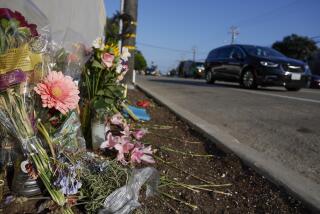Death Spurs Questions on PCH Safety Effort : Accidents: The latest fatality on the highway comes amid a campaign by law enforcement agencies and Caltrans.
Itâs a road thatâs harsh on driver mistakes.
Pacific Coast Highway has few guardrails to prevent cars from tumbling off its high cliffs into the ocean. No street lights illuminate the sharp curves. The seaside scenery can be a deadly distraction.
Ventura Countyâs nine-mile stretch of Pacific Coast Highway claimed another motoristâs life last weekend, raising questions about the effectiveness of a yearlong campaign to reduce accidents along the route between Oxnard and the Los Angeles County line.
Since the program started, fatalities on PCH have actually increased.
California Highway Patrol Officer Staci Morse, who has helped implement the safety campaign, said she is not discouraged by the increased deaths.
âWhat that tells me is that the program is needed,â Morse said. âWith what weâve been given, we feel weâve done really well.â
Last year, the CHP, the California Department of Transportation and local law enforcement agencies launched a driver safety campaign known as COAST--short for Concentrate on a Safe Trip.
At the time, officials cited statistics showing that from 1989 to 1991, the coastal highway was the scene of 13 fatal accidents and 284 injuries. In 1992, six fatal accidents and 98 injuries occurred.
The following year, when the safety program began, only two were killed and 78 injured.
But with 1994 less than half gone, the highway has already had four fatalities. Injury statistics were not available.
CHP and Caltrans officials defend their progress, saying they believe motorists have a heightened awareness of the roadâs dangers. As evidence, Morse cited âa lot of positive feedbackâ from people who tell her they have noticed new cautionary billboards on the road and have heard the campaignâs public service announcements on radio.
Morse and Caltrans engineer Bob Houle said the program can do only so much, and they expect a certain number of accidents regardless of any safety campaign.
*
When officials announced the $282,000 program, they said they intended to add more CHP officers to patrol that area, post warning signs and install reflectors on the ocean side of the highway.
But so far progress has been slow. Morse said that because the campaign involved several agencies, officials needed months of planning to coordinate the project properly.
âAny good program needs to be properly planned,â Morse said.
Parts of the highway have been repainted so motorists can see better, and some passing lanes were moved to less dangerous stretches of the highway. Six new warning signs were built along the route. Several public service announcements were issued to radio and print media.
But plans to beef up CHP patrols didnât get started until a few weeks ago, Morse said, because CHP officials decided that the summer months are the most popular time for motorists to use the coastal highway. Patrols were not stepped up last summer, she said, because officials were still gathering accident statistics and figuring out the best time to add more officers.
On Memorial Day weekend, CHP weekend patrols were boosted from two to eight officers at a time. When the program ends in September, the CHP will lose the overtime funding needed for those six extra officers, Morse said.
*
Caltrans officials are still awaiting funds for the roadside reflectors, Houle said, and it will be July, 1995, before all the roadside reflectors are installed.
A survey aimed at reducing the 55 m.p.h. speed limit has been requested but has not been conducted yet.
In 1992, Caltrans officials estimated that about 16,000 cars use the nine-mile ocean route annually. The most common cause of accidents was excessive speed and drunk driving, officials said.
âPeople drive faster than they ought to,â Houle said.
The safety program also includes Oxnard Boulevard, which connects the coastal highway to the Ventura Freeway. Police say Oxnard Boulevard has had more accidents than any other thoroughfare in the city and blame the problem partly on its high concentration of bars, liquor stores and late-night restaurants.
Oxnard police have been working with the CHP to curb the number of accidents along the thoroughfare by establishing sobriety checkpoints and adding more patrols.
But along the coastal highway, officials particularly warn against speeding motorists who take turns too quickly on the winding route.
âOne needs to be very careful on it,â said Alice Huffaker, transportation planner for the California Highway Patrol. âPeople are trying to drive it like a four-lane highway, rather than a two-lane highway.â
*
Investigators say the latest victim to die on PCH was traveling about 60 m.p.h. at the time of her accident.
On Sunday, 80-year-old Patricia Van De Water was on her way from Long Beach to attend her granddaughterâs graduation party in Santa Barbara when she lost control of her car for an unknown reason. Shortly before noon, Van De Waterâs car plunged off the cliffs south of Deer Creek Road and landed upside down in the ocean, causing her to drown.
Relatives said the elderly Long Beach woman was an alert driver who was familiar with the route, but had not driven it for some time.
âShe had been on the route numerous times, but not as a driver,â said Alice Van De Water, her daughter-in-law. âI canât remember the last time she drove that route, but she was not the type to fall asleep at the wheel or anything.â
Morse said PCH, with its scenic views, winding route and numerous pedestrians can distract motorists.
âIt only takes a quick second to check out the surf and have a pedestrian get in front of you,â Morse said.
More to Read
Sign up for Essential California
The most important California stories and recommendations in your inbox every morning.
You may occasionally receive promotional content from the Los Angeles Times.










